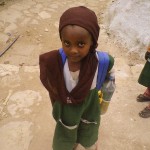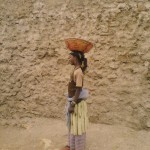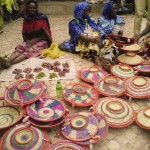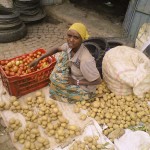Guyana | The Girl with the Notebook
A school girl from Harrare, Ethiopia.
Far too often the narratives about women and girls in rural communities whether they be in Asia, or Africa, or South America, are centered on an urgent call for them to look past the proverbial courtyard, to aim for a life beyond the confines of the village, to shed the veil. And we tell them that not doing so would render them invisible, marginalized, or trapped. We’re wrong.
BY GRACE ANEIZA ALI | THE GIRLS ISSUE | SPRING, 2013
There are no paved roads directly to Chaffe Jenetta — a small Muslim coffee farming community nestled in the remote terrains of Harrar in Eastern Ethiopia. Telephone lines and electric wires are rare in these parts. Women are immersed in their day—fetching water, gathering wood and sticks to stoke fires, and cooking for their families. Among their company, lush mountains and endless blue sky, I felt at home.
It was 2010 and my first time in Ethiopia, in fact my first trip to Africa. I had learned from growing up in Guyana and from a year traveling throughout India that there was no preparing for the rural countryside. You simply show up and let the land lead. So, I embraced Ethiopia with the same deference.
The journey to Harrar had started in New York City where I live. I was invited to travel with the staff and board members of The Abyssinian Fund, an NGO with a home-base in Harlem, New York, that works with coffee planters in Ethiopia’s rural villages like Chaffe Jenetta, helping them to grow better coffee, earn higher incomes, and improve social services with clinics, schools, and access to clean water.
While members of our group toured the village, I spent most of my time with the school children. One little girl in particular, about nine or ten years old, caught my attention — simply because of the way she clutched her notebooks. I asked for her name, but either she was too shy to tell me or didn’t understand my question. I pointed to her books and asked if I could look at them. Her notes, written in Oromo, the local language of Chaffe Jenetta, filled up every usable blank space. Her handwriting was in the margins, on the inside and outside of the covers, written horizontally and vertically.
I recalled my own primary school days in Guyana when notebooks and paper were a luxury. Instead, we had hand-held chalkboards and little bits of chalk. It was cheaper, but it meant everything that was written had to be erased. So I would gather sheets of paper wherever I could find them and glue or sew them together to make books. It was within those pages that I could invent the life I wanted. I wanted to be a writer.
Like that little girl at my side in Chaffe Jenetta, I left no free space unmarked in my hand-made books. I too wrote in the margins, within the covers, and sideways. As I turned the pages of her book, I wondered if this was where the stories of Chaffe Jenetta were being kept. Were they scribbled within the margins? Were they tucked in between the covers?
One of the Ethiopian guides that accompanied our group had remarked, “These are the forgotten people.” He had never been this deep into the mountains of Harrar and was visibly moved by the agrarian way of life in Chaffe Jenetta. Perhaps what he was witnessing made him feel as a foreigner in his own land.
But as I stood there looking through this little girl’s notebooks, nothing about her seemed forgotten to me. There was a boldness about her. There was a joyfulness about her. What I saw was a young girl thriving amidst her circumstances. I’ve found this to be universal from Harrar to Harlem — people thriving amidst contradictions, thriving in the messiness of life, thriving in the tragedies, thriving in the challenges, the hurts and the disappointments.
Notebooks may seem trivial when compared to the serious needs in Chaffe Jenetta like clean water, clinics, and paved roads. But they represent the freedom to dream, to create, and to imagine a future for oneself. For that little girl, her future begins within the pages of her notebook — just like my dreams began for me. It was clear by the way she clung to her books, their pale blue covers tattered and torn, that what was written in them was of value. They were sacred to her.
Far too often the narratives about women and girls in rural communities whether they be in Asia, or Africa, or South America, are centered on an urgent call for them to look past the proverbial courtyard, to aim for a life beyond the confines of the village, to shed the veil. And we tell them that not doing so would render them invisible, marginalized, or trapped. We’re wrong.
Chaffe Jenetta is not another nameless village in another ubiquitous story of poverty in Africa. It is a challenging but wealthy place — albeit not material wealth. It is not a place to flee from, but one to be nurtured and supported. The little girl I met could one day turn out to be a powerful voice for Ethiopia. She might become a writer herself, sharing with the world its multiple stories. And to do so, perhaps she will find herself returning to those very notebooks.
Gallery: Women and Girls of Harrar, Ethiopia. Photo Credit: Grace Aneiza Ali
Click any image to launch photo gallery.
♦
Grace Aneiza Ali is the founder and editorial director of Of Note Magazine.
 OF NOTE Magazine is free to readers, free of advertising, and free of subscriptions—all made possible by generous supporters like you. Please consider making a tax-deductible gift.
OF NOTE Magazine is free to readers, free of advertising, and free of subscriptions—all made possible by generous supporters like you. Please consider making a tax-deductible gift.
OF NOTE Magazine is a fiscally sponsored organization of Artspire, a program of the New York Foundation for the Arts, a 501 (c) (3), tax-exempt organization. All donations are 100% tax-deductible to the full extent of the law.







